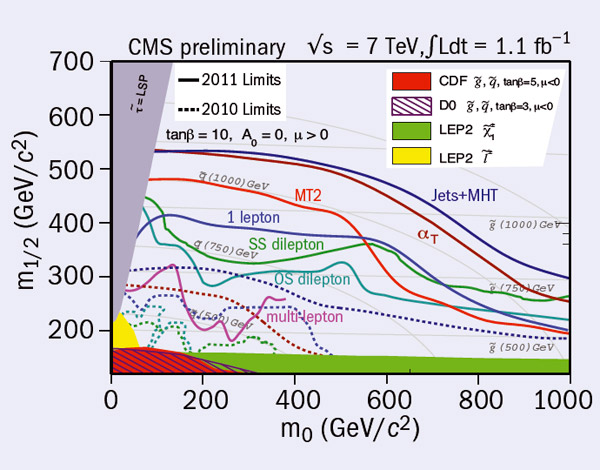
Supersymmetry (SUSY) is still one of the strong candidates for physics beyond the Standard Model that could be detected in proton–proton collisions at the LHC. It could solve many of the outstanding issues in particle physics, such as the gauge hierarchy problem. SUSY can reveal itself through the production of new heavy particles and could therefore deliver a natural candidate particle to explain the large density of dark matter in the universe. However, it has so far evaded the current searches in both the CMS and ATLAS experiments.
The figure shows a compilation of many of the most recent public results of CMS for integrated luminosities of about 1–2 fb–1. It illustrates the reach of the analyses with respect to pre-LHC experiments in the plane of the universal scalar and gaugino masses (m0 and m1/2, respectively) at the grand unified theory scale of the constrained minimal supersymmetric extension of the Standard Model (CMSSM).
A large increase in sensitivity was clearly obtained at the LHC with the data analysed, obtained in 2010 and until August 2011, but this parameter space is just one reference point among possible SUSY scenarios. Additional data will allow the exploration of other scenarios where each of the signatures, from no-leptons to multileptons, may have the most sensitivity. The search channels shown varied from having a few to many jets (αT, Jets+MHT, MT2), and jets plus one lepton (i.e. generally one muon or electron), jets plus two leptons, with either opposite (OS) or the same (SS) charge. All of these channels were also required to have a large missing transverse energy. The latter is a key characteristic of many SUSY searches, reflecting the supposition that the lightest SUSY particle is expected to be neutral, stable and weakly interacting – thereby escaping detection.
CMS recently released the results of SUSY searches for candidates containing at least three leptons. For these search channels, the Standard Model background is low, mostly di-boson events; this allows the missing transverse energy requirement to be relaxed considerably and so provide sensitivity to SUSY models with so-called R-parity violation. In these models, SUSY particles decay to Standard Model particles and no dark-matter candidate can escape detection. Moreover, such studies are sensitive to the channel of direct electroweak gaugino production, important in scenarios that conserve R-parity.
CMS analysed a total of 2.1 fb–1 of data. In general no significant excess was observed in this new analysis – so SUSY, if it exits, still manages to hide away. As many as 52 different channels have now been looked into and although a few of them show a slight excess over the background estimated from data, all of them currently have a significance of less than 2σ. CMS will certainly continue to “watch this space”.
At the time of this writing, more than 5 fb–1 of data have been recorded and are now being analysed. It promises to be an interesting winter for SUSY searches.
Further reading
For more on the multilepton analyses, see CMS-EXO-11-045 and CMS-SUS-11-013.





